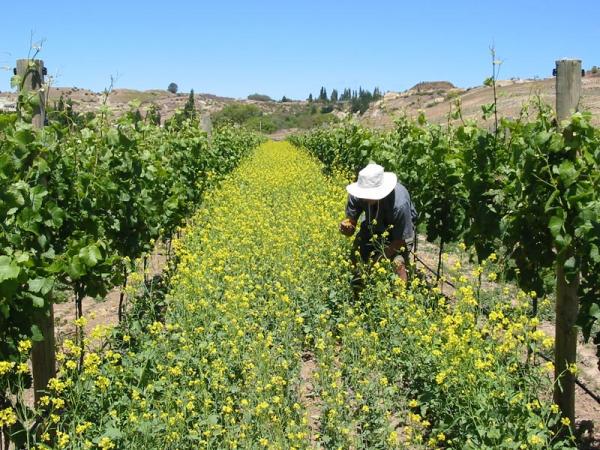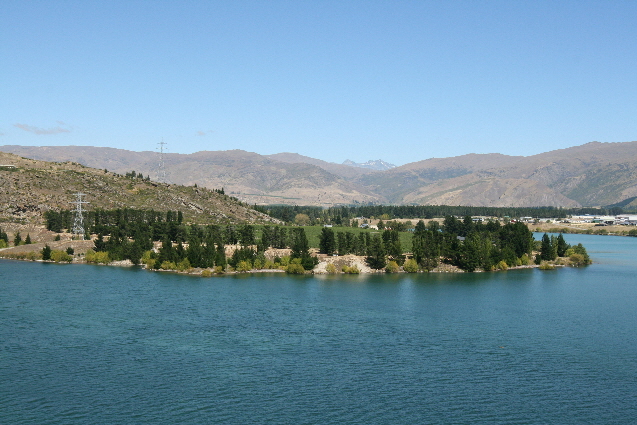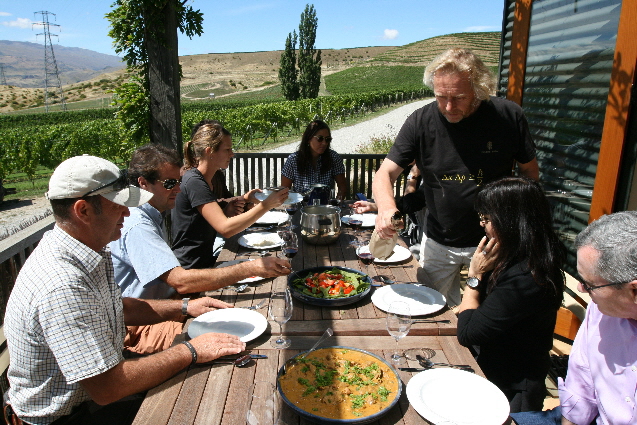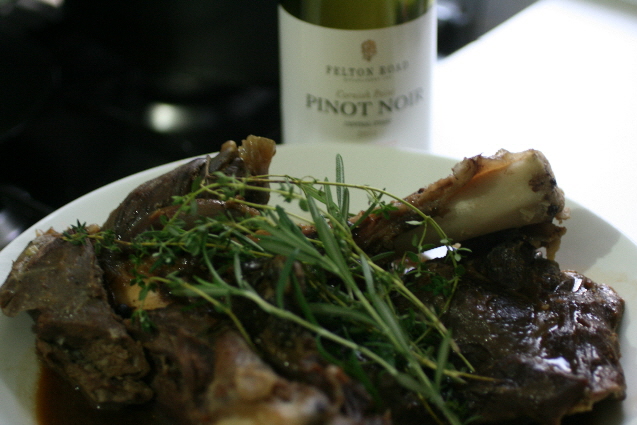Pinot noir enthusiasts the world over hardly need any convincing that Felton Road make extraordinarily good, arguably great pinot noir, however that does not mean I can’t have my say as well.
Moreover, the stars seemed aligned in many respects for this appraisal, in part because I found a long-lost notebook with my tasting notes on a brilliant vertical we enjoyed at my residence in Singapore with winemaker Blair Walter, gee about four years ago! Reading through my notes reinforced how intriguing Felton Road wines are and although these tasting notes are somewhat dated, I will be posting them as an archive.

Felton Road Vineyard Mustard Cover Crop
Another contributing factor is the ongoing dialogue I have with Felton Road proprietor, Nigel Greening, on biodynamic viticulture and its ideologies, complexities and the practicalities of organics in working towards a totally sustainable ecosystem fully encompassing the vineyard property.
Greening is one of the most compelling orators on biodynamic philosophy, actually he’s one of the few people I have come across who can cut through the compost and explain such a complex and intricate subject without getting too metaphysical or hippie-emotional. He can do biodynamics for dummies as convincingly as he can present a paper at a biodiversity and climate-change conference—to which Greening has generously allowed me to reproduce a fascinating and profound speech that he delivered at the World Climate Conference on the subject – click here
Greening is also a marketing genius and has greatly influenced the evolution of the New Zealand wine industry over the last ten years or more and is an indefatigable ambassador for the country on the international wine stage. I have dubbed him the Dalai Lama of winegrowing, gastronomy and practically any subject you can think of; he is an “Ocean of Wisdom” and always full of inspirational and pragmatic enlightenment and his plain logic and moral compass empowering.
All the wines that Felton Road produce are mightily impressive—mineral-infused, lime zesty, tantalizing and pristinely balanced rieslings—seamless chardonnays with mouth-watering citrus succulence and restrained purity—rich, layered and profoundly complex pinot noirs—that rightly have a dedicated following the world over.
Understandably their pinot noirs garner more attention with the universal allure and infatuation of this red grape variety; certainly the plaudits of wine critics and consumers for Felton Road Pinot Noir are well-deserved. And no doubt there will some who have a particular preference between their Bannockburn Single-Vineyards or Block Pinot’s, perhaps a favourite, although surely it is feasible to like all them.
As much as Greening is insistent there is no hierarchy in these individual cuvees and that it is simply a matter of site expression, consumers have not ignored the rarity factor of the Block 5 and Block 3 Pinot’s and with the scarcity and higher prices pigeonholing these wines to a higher classification. And let’s face it; the Block 5 is an awesome wine.
Nothwithstanding I unequivocally like all of their pinots, I also support Greening’s site-expression theory, putting their Bannockburn cuvee to one side (in terms of it being a blend of all their vineyards/blocks), the winemaking is exactly the same for all the wines. Indeed, Greening explains the winemaking process and oak- maturing as “ludicrously simple”, with a roll of the eyes and a broad grin from winemaker Blair Walter listening in to the well-rehearsed locution.

Felton Road Cornish Point vineyard
From a site-expression perspective—which is after all the ultimate attribute of great pinot noir— the wine that impresses me most and perhaps underrated in the scheme of their wines, is the Felton Road Cornish Point Noir. Actually, I would go as far to say this is the most unique and intensely expressive pinot noir in all New Zealand with an unmistakable signature of dense black (berry) fruits and floral rose petal perfume with an intriguing deep-spiciness and minerally, earthy, dried-herb secondary complexities embodied in lush and layered richness.
Even more intriguing is the deceptive proportions of the wine, seemingly monumental in its hedonistic bouquet yet soft and silky in texture, and energized in its perky, succulent fruit—a style that I particularly like. I have enjoyed three successive vintages—2009, 2010 and the newly released 2011—all in the space of one year here in Singapore. I assume this partly attributed to 2009 yield being a thimbleful, so 2010 filled the vacuum and 2011 made it just in time before there was dry argument.
All three wines showed the signature characteristics but you could see the vintage attributes, the 2009 relatively firm and brooding in its concentration with dusty tannin grip and best left for a good 10 years in the cellar. The 2010 showed the perfect ripeness and excellent balance of this year, but again I would be leaving in this in the cellar for many years. The 2011, at this stage, is resplendent in its baby fat and defies logic in its drinkability but I envisage this wine will evolve over two decades moreover, contrary to the negative reports on Central Otago 2011 vintage, is in my opinion one of the most stunning wines Felton Road has made to date.

www.feltonroad.com
My full tasting note on the Felton Road Cornish Point Pinot Noir 2011 reads:
A hedonistic perfume of mulberry, blueberry, blackberry with a powerful scent of rose petal and juniper berry, there’s a wonderful smokiness with salami, savoury, meaty notes and captivating secondary nuances, tamarind paste, balsamic, dried herbs and a briary, earthiness with rather intriguing salty driftwood smells, minerally river rock pebbles and wet clay. These aromas build and intensify as the wine breaths out—over an hour or so—to a hedonistic cornucopia a dark cherry, plum compote and an intense spiciness almost in a spicy Northern Rhone-like syrah way although without the dominant ground black pepper, and deeper, more Indian spice-box thrown into a hot wok and energizing, like inhaling hot black Chai tea. The palate gushes with dark fruits, plush, rich, creamy and layered textures with dark chocolate notes yet there’s a perky concentration of raspberry in the mid-palate almost eau de vie like in intensity. It is silky and soft in texture yet firmly structured with dusty tannins and a warm glow to the farewell, indeed there’s terrific energy and a spicy-warmth to the wine. This is an enthralling expression of pinot noir and even more so in its heightened deep spice. You really do need to let it breathe for a good hour or more, something that pinot drinkers understand, in that this a variety that changes in the glass constantly and underpins the intrigue of pinot noir.
I am convinced Cornish Point is a very special terroir—a singularly unique vineyard site—that clearly defines itself within the Bannockburn region. It was named after the Cornish gold miners who lived there in a settlement and in fact where the first large find of gold was made in the 1860s Central Otago gold rush, to which in my mind, history has repeated itself only the precious element is terroir and the grape vine.
Greening bought the land when it was in largely a derelict apricot orchard, planting it with vines in 2000. Looking across from the Cromwell-Clyde Road, the vineyard even looks distinguished, a small promontory that is completely surrounded by water, on one side by the Clutha River and on the other by the Kawarau River, giving it an appearance of an island and I can’t help make the comparison to the French term Clos only it’s a wall of water instead of stones.
Felton Road’s brilliant website details the soils “classed as Manuherikia soils: ‘moderately deep fine sandy loams’. They are of windblown origin (loess soils) lying on bands of river gravel and older silts and would date from the retreat of the glaciers up the Cromwell valley over 20,000 years ago. Deeper down there is clay and calcium carbonate speckles at the base of stones. The parent rock is schist. These soils are typical of the fine but heavy soils we look for when planting pinot noir.”
Highlighting Felton Road as my Biodynamic Vigneron of the Lunar Year (Rabbit) encompasses acknowledging the hard toil of Felton Road viticulturist, Gareth King, and winemaker, Blair Walter; their implementation and day-to-day painstaking work in managing an organic vineyard and a property that fully embraces biodynamic principals is commendable with Felton Road the benchmark for New Zealand vignerons.
As with all the ‘Must-Have Wines that have made it into the Wandering Palate retrospective review “Best Wines of the Lunar Year”, this wine has been tried over a of meal, as you would normally enjoy them moreover, their intended purpose.
Whenever I think of pairing food with Felton Road Pinot Noir, I always think of goat; yes I know it sounds a bit strange but Nigel Greening’s infatuation with his vineyards African mountain goat herd goes beyond keeping the properties weeds and briar under control (negating the use of herbicides) and he is rather partial to roasted goat and goat curry, to which I can attest he has perfected these dishes having enjoyed them in his company on many occasions.

The is no better vineyard lunch table than sitting down with the crew at Felton Road and Nigel Greening knocking up one of his fantastic goat curries and fresh vegetables straight out of the Felton Road vineyard garden - and of course a glass of pinot noir
A true gourmand and altruistic chef, Greening is always happy share recipes, to which he has detailed his favourite goat dishes – click here
Having procured a shoulder and leg of young goat from Mr Haji M.N. Shahul Hameed, my trusted goat and mutton stall (01-127) at Tekka Market in Singapore, I decided to slow pot-roast it using the same recipe for Arrosto di agnello al ginepro—Casserole-roasted lamb—from Marcella Hazan’s timeless reference, “The Classic Italian Cookbook”, who suggests young goat works equally well with this dish.
It is a down-to-earth one pot dish that is ridiculously easy to cook with practically nothing to do but watch the pot occasionally, and yet it is such a flavoursome and intriguing dish that one can embellish the narrative of your kitchen labours and intellectualise to impress your guests beyond all expectations.

Slow-roasted goat and Felton Road Cornish Point Pinot Noir
The meat in this slow-cook technique is simmered right from the start with vegetables, wine and flavourings with no browning or cooking oil involved as the meat supplies its own fat and juices as it cooks.
You will need, 1 tablespoon chopped carrot, 2 tablespoons chopped onion, 1 tablespoon chopped celery, 2 cloves garlic (lightly crushed), some springs of fresh rosemary and thyme (or half teaspoon each dried), 2 teaspoons juniper berries, 250ml dry white wine, salt and several grinds of the peppermill. Serving 4 to 6 people, you will need a leg or shoulder of goat weighing around 1.5 kg with bone in.
Throw it all in the pot! Yes, simply put all the ingredients into a heavy casserole and cover (lid closed), cooking on top of the stove at a low heat for 2 hours, turning the meat every 45 minutes. At this point the goat should have thrown off a considerable amount of liquid. Set the lid askew, and cook for another hour at slightly higher heat. The meat should now be a rich brown colour and very tender when pricked with a fork.
Remove from the pot and set aside. I use the leftover liquid, now quite reduced, to make a sauce, straining through a chinois and adding a cup of pinot noir and two tablespoons of demi-glaze, all simmered in a pan for a few minutes to a rich gravy consistency and poured over the goat, served in a large white deep plate and garnished with rosemary sprigs.
Putting both the goat dish and pairing of Felton Road Cornish Point Pinot Noir 2011 to the test, I invited my good drinking buddy, Chris, around for dinner, who is unashamedly an old-world-biased palate and Burgundy zealot.

Chris, unashamedly an old-world-biased palate and Burgundy zealot, now Felton Road convert
Much to his surprise (but as I expected), Chris was very impressed with the Cornish Point and is now another Felton Road convert, sending a note the next day, “A quick thank you for a most splendiferous meal of goat last night and some splendid wine too. Goat and the pinot do go very well together. The pinot was very good indeed; as I said a surprisingly light and refreshing wine on the palate given its nose which reminded me that the top end of the Rhone is not so far from Burgundy; promises to be a sophisticated bottle in a few years.”
I have to say this dish is utterly brilliantly with the Felton Road Cornish Point Pinot Noir; the rosemary, thyme and juniper berry infused through the goat meat wonderfully simpatico with the bouquet of the wine—and the dark, slow-roast flavours of the goat and the savoury brown sauce picking up on the richness in the wine. And it was after all, a ‘flower day’ in the biodynamic calendar and the wine was showing particularly well.
I had intended to experiment with one of Greening’s goat curries with the leftovers the following day however did not have time and opted to use my mother-in-laws incredibly good homemade Nonya red (normally used for beef) curry paste, quickly knocking up a coconut based curry sauce and simmering slowly with pieces of the roasted goat.
It was another great culinary success and the deep spiciness and power of the Cornish Point when superbly, picking up on the spicy warmth of the red curry and the overall richness of the dish. I am convinced Felton Road Cornish Point Pinot Noir is the ultimate ‘Goat Curry’ wine; yes you may say an esoteric pairing but there are few pinot noirs in the world that have the sweet-richness of fruit and suppleness of tannin yet power to handle curries. Ok, it’s a niche market, but then there’s not much of this wine around anyway.
Actually, you would be wise to visit this link immediately http://www.feltonroad.com/distribution/ to find a distributor in your country and secure a case for the cellar (at a minimum) and a few more bottles to try now. It sells for S$88 a bottle in Singapore, or 35 through Laithwaites in the UK, which in the world of truly great pinot noir is not a lot of money; actually it is extraordinary good value when you compare it to…well, we not allowed to say the ‘B’ word in New Zealand.
For more on Felton Road biodynamics, read ‘Meet Kaz, the New Zealand Falcon: Felton Road’s new bird deterrent system for the 2013 vintage’ – click here
|
|
Tweet |






No comments to New Zealand Red Wine of the Lunar Year (Dragon) & Biodynamic Vigneron of the Lunar Year Felton Road Cornish Point Pinot Noir 2011, Central Otago, New Zealand | Comments Feed
No comments yet
The comments are closed.